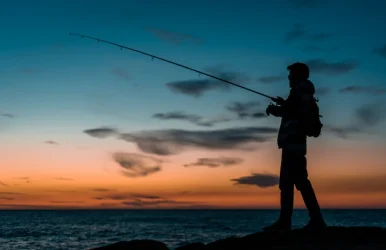Unlocking The Mysteries Of Fishing: Optimal Times Revealed
BY Mony ShahDec 19, 2023
Deciding on the optimal time for a successful fishing trip involves more than just grabbing your rod and heading to the lake. Fishing weather and timing play a major role in enticing fish to actively bite. Understanding the intricate factors impacting fish behavior can make the difference between an epic day of catches or an empty-handed outing. The concept of peak fishing weather windows may seem complicated for novice anglers. However, learning a few basics about weather patterns, seasons, times of day, and other influential elements will set you up to unlock the ideal moments. Arm yourself with this vital timing knowledge to begin consistently landing trophy catches during your fishing ventures. Paying Close Attention to Time Zones Believe it or not, time zones actually matter quite a bit when seeking the best fishing times. Fishing weather models track fishing hours based on time zones because this helps predict two prime factors - sunlight and warmth throughout the day. Fish tend to bite more around sunrise or sunset due to the shifting positions of the sun, and weather warmth greatly impacts how fish metabolisms function. So even just a single-hour difference east and west can shuffle the peak activity periods. While apps and sites may list general guidelines for top fishing hours, anglers should always cross-reference the recommendations with their specific time zone for improved accuracy. Adapting Strategies to Match the Weather Weather elements like temperature, wind levels, and precipitation greatly affect fish behavior patterns. As fishing weather shifts day-to-day, expert anglers learn to alter tactics to make the most of the conditions dealt to them. On hot, sunny days, fish instinctively head to deeper waters, offering refuge from the intense heat. Successful anglers rely on bottom-running rigs with weighted lures to reach the fish in their cooler hideouts. Alternatively, overcast days with little to no wind often present almost perfect opportunities to break out topwater lures and fly rods for epic surface strikes. During rain storms, savvy lifelong fishermen turn to chatter baits and spinnerbaits - lures with vibrations that realistically mimic bait fish struggles. This extra commotion cleverly attracts active predators looking for an easy meal. In essence, closely observe the variables nature offers up to decide on good weather for fishing and then strategize your approach accordingly based on the presence of both positive and negative conditions. Attuning Your Efforts to Seasonal Patterns Fish species follow natural annual cycles regarding their prime feeding and spawning activities. Tuning into these annual patterns will clue you into recurring windows of exceptional fishing via yearly cycles like: Spring - Pre-spawn staging makes for very active biting before the actual spawning season begins. Target warmer, shallow waters to catch fish aggressively feeding to fuel up for spawning. Summer - Post-spawn feeding frenzies happen as fish regain strength after spawning stress. Focus on productive structures hosting large amounts of insects and bait fish. Fall - Fish prepare for winter months by voraciously feeding to pack on extra weight. Bump up lure sizes for reaction bites from these feasting fish. Winter - Deep, slower, subtle presentations are often best as the whole fish moves and feeds remarkably less. But cold snaps quickly heating up water can trigger short intense reaction bites. Related: Six Important Factors To Consider Before Planning Alaska Fishing Trip Fine-Tuning Tactics to Different Times of Day Beyond major influences like weather patterns and seasons, the actual time of day also significantly impacts which fishing strategies will be most productive. Early Morning hours often allow peaceful fishing conditions as the waters calm. Target shallow water structures while fish actively chase bait, revealed by the slowly growing morning sunlight. Mid-Day sun can quickly send fish retreating into thicker cover or considerably deeper channels away from the brightness. Slow down presentations by utilizing jigs or crankbaits capable of running deeper. Dusk brings another wave of vigorous fish activity. Break out those trusty topwater plugs and get ready to capitalize as bait fish also become more active. Remain alert to shifts in fish behavior based simply upon the natural passage from morning to afternoon to evening. Vary approaches appropriately as needed. Conclusion While rather intricate at first, once fully grasped, the concepts around prime fishing times can bring order to the complex puzzle of precisely when to catch more fish. Heed key patterns related to time zones, unpredictable weather factors, seasons, and daylight conditions. Combine these elements with area-specific knowledge regarding fish behaviors and frequently favored structure spots. Then, narrow down the most promising timing windows to strategically play the odds in your favor for an epic haul. Eliminate the pure guesswork and stack the deck towards success by unlocking the secrets of timing for a winning day of fishing. Read Also: A Guide To Traverse City Beach – 10 Best Beaches To Explore 10 Best Restaurants On Sanibel Island – Tour And Travel Guide When Can Navigation Rules Be Overlooked?










 Latest
Latest




